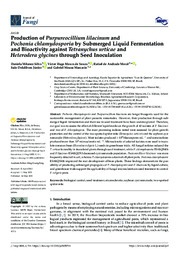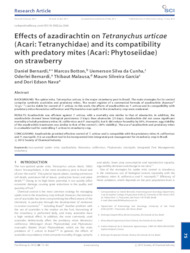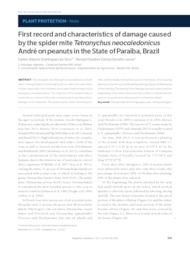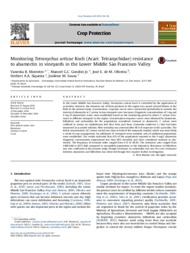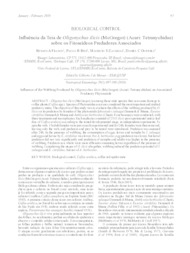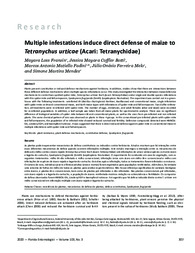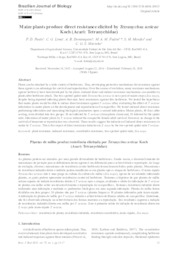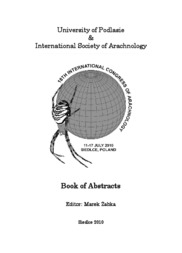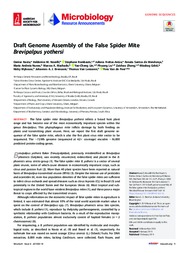Busca de Publicações
Filtrar por:
| Autoria: SILVA, D. M.; SOUZA, V. H. M. de; MORAL, R. de A.; DELALIBERA JÚNIOR, I.; MASCARIN, G. M. Abstract: Pochoniachlamydosporia and Purpureocilliumlilacinum are fungal bioagents used for the sustainable management of plant parasitic nematodes. However, their production through submerged liquid... ... |
| Autoria: BERNARDI, D.; BOTTON, M.; CUNHA, U. S. da; BERNARDI, O.; MALAUSA, T.; GARCIA, M. S.; NAVA, D. E. BACKGROUND: The spider mite, Tetranychus urticae, is the major strawberry pest in Brazil. The main strategies for its control comprise synthetic acaricides and predatory mites. The recent register of... ... |
| Autoria: SILVA, C. A. D. da; GONDIM JÚNIOR, M. G. C. The red spider mite Tetranychus neocaledonicus André (Acari: Tetranychidae) is commonly found on cotton and castor bean in Brazil, especially in the northeast, but to date it had not been found damagi... ... |
| Autoria: MONTEIRO, V. B.; GONDIM JÚNIOR, M. G. C.; OLIVEIRA, J. E. de M.; SIQUEIRA, H. A. A.; SOUSA, J. M. In the Lower Middle Sao Francisco Valley, Tetranychus urticae Koch is controlled by the application of acaricides; however, the intensive use of these products in this region has caused control failur... ... |
| Autoria: MARTINS, M. I. G.; SANT'ANA, A. E. G.; VASCONCELOS, F. M. T.; SILVA, W. L.; LIMA, L. M. de; CARVALHO, R.; MELO FILHO, P. A.; SANTOS, R. C. dos Essential plant oils contain biopesticides that could be used to control many crop pests. Tetranychus spp. are mites that cause damage to several crops and are primarily controlled by synthetic pestic... ... |
| Autoria: FRANCO, R. A.; REIS, P. R.; ZACARIAS, M. S.; OLIVEIRA, D. C. ABSTRACT - Oligonychus ilicis (McGregor) is among those mite species that can cause damage to coffee plants (Coffea spp.). Species of Phytoseiidae acari are considered the most important and studied p... ... |
| Autoria: FRANZIN, M. L.; BOTT, J. M. C.; FADINI, M. A. M.; MELO, J. O. F.; MENDES, S. M. Plants present constitutive or induced defense mechanisms against herbivory. In addition, studies show that there are interactions between these different defense mechanisms when multiple species infe... ... |
| Autoria: PAULO, P. D.; LIMA, C. G.; DOMINIQUINI, A. B.; FADINI, M. A. M.; MENDES, S. M.; MARINHO, C. G. S. Plants can be attacked by a wide variety of herbivores. Thus, developing protective mechanisms for resistance against these agents is an advantage for survival and reproduction. Over the course of evo... ... |
| Autoria: LO-MAN-HUNG, N. F.; MARICHAL, R.; BONALDO, A. B.; CARVALHO, L. S.; INDICATTI, R. P.; TSELOUIKO, S.; PRAXEDES, C.; BROWN, G. G.; VELASQUEZ, E.; DECAËNS, T.; MARTINS, M.; LAVELLE, P.
|
| Autoria: NAVIA, D.; NOVELLI, V. M.; ROMBAUTS, S.; FREITAS-ASTUA, J.; MENDONÇA, R. S. de; NUNES, M. A.; MACHADO, M. A.; LIN, Y.-C.; LE, P.; ZHANG, Z.; GRBIC, M.; WYBOUW, N.; BREEUWER, J. A. J.; LEEUWEN, T. V.; PEER, Y. V. de
|
Observações
1 - Por padrão são exibidas publicações dos últimos 20 anos. Para encontrar publicações mais antigas, configure o filtro ano de publicação, colocando o ano a partir do qual você deseja encontrar publicações. O filtro está na coluna da esquerda na busca acima.
2 - Para ler algumas publicações da Embrapa (apenas as que estão em formato ePub), é necessário ter, no celular ou computador, um desses softwares gratuitos. Sistemas Android: Google Play Livros; IOS: iBooks; Windows e Linux: software Calibre.
Acesse outras publicações
Acesse a Base de Dados da Pesquisa Agropecuária (BDPA) para consultar o acervo completo das bibliotecas da Embrapa.

